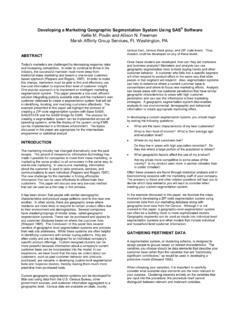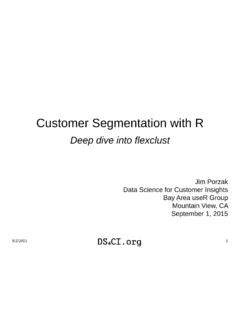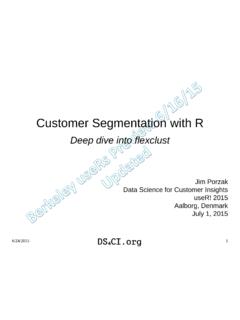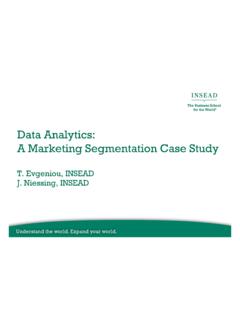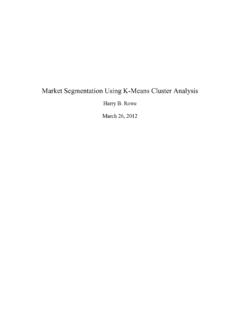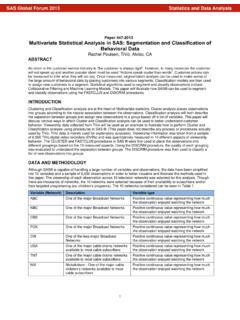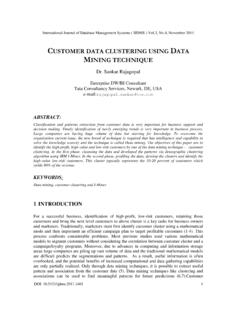Transcription of Customer Segmentation Using Clustering and Data …
1 Abstract Clustering technique is critically important step in data mining process. It is a multivariate procedure quite suitable for Segmentation applications in the market forecasting and planning research. This research paper is a comprehensive report of k-means Clustering technique and SPSS Tool to develop a real time and online system for a particular super market to predict sales in various annual seasonal cycles. The model developed was an intelligent tool which received inputs directly from sales data records and automatically updated Segmentation statistics at the end of day s business. The model was successfully implemented and tested over a period of three months. A total of n = 2138, Customer , were tested for observations which were then divided into k = 4 similar groups. The classification was based on nearest mean.
2 An ANOVA analysis was also carried out to test the stability of the clusters. The actual day to day sales statistics were compared with predicted statistics by the model. Results were quite encouraging and had shown high accuracy. Index Terms Cluster analysis, data mining, Customer Segmentation , ANOVA analysis. I. INTRODUCTION Highlight Clustering is a statistical technique much similar to classification. It sorts raw data into meaningful clusters and groups of relatively homogeneous observations. The objects of a particular cluster have similar characteristics and properties but differ with those of other clusters. The grouping is accomplished by finding similarities among data according to characteristics found in raw data [1]. The main objective was to find optimum number of clusters. There are two basic types of Clustering methods, hierarchical and non-hierarchical.
3 Clustering process is not one time task but is continuous and an iterative process of knowledge discovery from huge quantities of raw and unorganized data [2]. For a particular classification problem, an appropriate Clustering algorithm and parameters must be selected for obtaining optimum results. [3]. Clustering is a type of explorative data mining used in many application oriented areas such as machine learning, classification and pattern recognition [4]. In recent times, data mining is gaining much faster momentum for knowledge based services such as distributed and grid computing. Cloud computing is yet another example of Manuscript received December 25, 2012; revised February 28, 2013. Kishana R. Kashwan is with the Department of Electronics and Communication Engineering PG, Sona College of Technology (An Autonomous Institution Affiliated to Anna University), TPT Road, Salem-636005, Tamil Nadu, India (e-mail: C.)
4 M. Velu is with the Department of CSE, Dattakala Group of Institutions, Swami Chincholi, Daund, Pune 413130, India (e-mail: frontier research topic in computer science and engineering. For Clustering method, the most important property is that a tuple of particular cluster is more likely to be similar to the other tuples within the same cluster than the tuples of other clusters. For classification, the similarity measure is defined as sim (ti, tl), between any two tuples, ti , tj D. For a given cluster, Km of N points {tml, tm2 .. tmN}, the centroid is defined as the middle of the cluster. Many of the Clustering algorithms assume that the cluster is represented by centrally located one object in the cluster, called a medoid. The radius is the square root of the average mean squared distance from any point in the cluster to the centroid. We use the notation Mm to indicate the medoid for cluster Km.)
5 For given clusters Ki and Kj, there are several ways to determine the distance between the clusters. A natural choice of distance is Euclidean distance measure [5]. Single link is defined as smallest distance between elements in different clusters given by dis(Ki, Kj) = min(dist(ti1, tjm)) til Ki Kj and tjm Ki Kj. The complete link is defined as the largest distance between elements in different clusters given by dis (Ki, Kj) = max (dis (til, tjm)), til Ki Kj and tjm Kj Kj. The average link is the average distance between elements in different clusters. We thus have, dis(Ki, Kj) = mean(dis(til, tjm)), til Ki Kj, tjm Kj Kj. If clusters are represented by centroids, the distance between two clusters is the distance between their respective centroids. We thus have, dis (Ki, Kj ) = dis (Ci, Cj), where Ci and Cj are the centroid for Ki and Kj respectively.
6 If each cluster is represented by its medoid then the distance between the cluster can be defined as the distance between medoids which can be given as dis ( Ki , Kj )=dis (Mi, Mj ), where Mi and Mj are the Medoid for Ki and Kj respectively II. K-MEANS Clustering TECHNIQUE The algorithm is called k-means due to the fact that the letter k represents the number of clusters chosen. An observation is assigned to a particular cluster for which its distance to the cluster mean is the smallest. The principal function of algorithm involves finding the k-means. First, an initial set of means is defined and then subsequent classification is based on their distances to the centres [6]. Next, the clusters mean is computed again and then reclassification is done based on the new set of means. This is repeated until cluster means don t change much between successive iterations [7].
7 Finally, the means of the clusters once again calculated and then all the cases are assigned to the permanent clusters. Given a set of observations (x1, x2,.., xn), where each observation xi is a d-dimensional real vector. The k-means Clustering algorithm aims to partition the n observations into k Customer Segmentation Using Clustering and Data Mining Techniques Kishana R. Kashwan, Member, IACSIT, and C. M. Velu International Journal of Computer Theory and Engineering, Vol. 5, No. 6, December 2013856 DOI: groups of observations called clusters where k n, so as to minimize the sum of squares of distances between observations within a particular cluster [8]. As shown in Table I, the sum of squares of the distance may be given by the equation arg min S = i=1 sj si ||xj j||2, where i is the mean of points in Si. Given an initial set, k-means computes initial means m1 (1).
8 ,mk(1) and it identifies k clusters in given raw data set. TABLE I: K-MEANS ALGORITHM Simplified simulation flow of k-means algorithm Begin Inputs: X = (x1, x2,.., xn) Determine: Clusters k Initial Centroids - C1, C2,.., Ck Assign each input to the cluster with the closest centroid Determine: Update Centroids - C1, C2,.., Ck Repeat: Until Centroids don t change significantly (specified threshold value) Output: Final Stable Centroids - C1, C2,.., Ck End In most of the cases, k-means is quite slow to converge. For very accurate conditions, it takes quite a long time to converge exponentially. A reasonable threshold value may be specified for conversing in most of the cases to produce quick results without compromising much accuracy [9]. As shown in Table II, the Sum of Square of Errors (SSE) may be considerably reduced by defining more number of clusters. It is always desirable to improve SSE without increasing number of clusters which is possible due to the fact that k-means converges to a local minimum [10].
9 To decrease SSE, a cluster may be split or a new cluster centroid may be introduced. TABLE II: BISECTING OF K-MEANS ALGORITHM Bisecting sequence of k-means algorithm Begin Initialize clusters Do: Remove a cluster from list Select a cluster and bisect it Using k-means algorithm Compute SSE Choose from bisected clusters one with least SSE Add bisected clusters to the list of clusters Repeat: Until the number of cluster have been reached to k End To increase SSE, a cluster may be dispersed or two clusters may be merged. To obtain k-clusters from a set of all observation points, the observation points are split into two clusters and again one of these clusters is split further into two clusters. Initially a cluster of largest size or a cluster with largest SSE may be chosen for splitting process. This is repeated until the k numbers of clusters have been produced.
10 Thus it is easily observable that the SSE can be changed by splitting or merging the clusters [11]. This specific property of the k-means Clustering is very much desirable for marketing Segmentation research. The new SSE is again computed after updating cluster centroid. This is repeated until SSE is reached to a minimum value or becomes constant without changing further, a condition similar to congruence. The SSE is represented mathematically by SSE = i=1( i - x)2 where i is the centroid of ith cluster represented by ci and x is any point in the same cluster. A condition for achieving minimum SSE can be easily computed by differentiating SSE, setting it equal to 0 and then solving the equation [12]. 2121()()2()0iiikkiix ckkkiix ckikxckkkxcSSExxxmx Here mk is total number of elements and K is centroid in kth cluster ck. Further it can be simplified as 1kkkxckxm This concludes that the minimum SSE can be achieved under the condition of the centroid of the cluster being equal to the mean of the points in the kth cluster ck.


